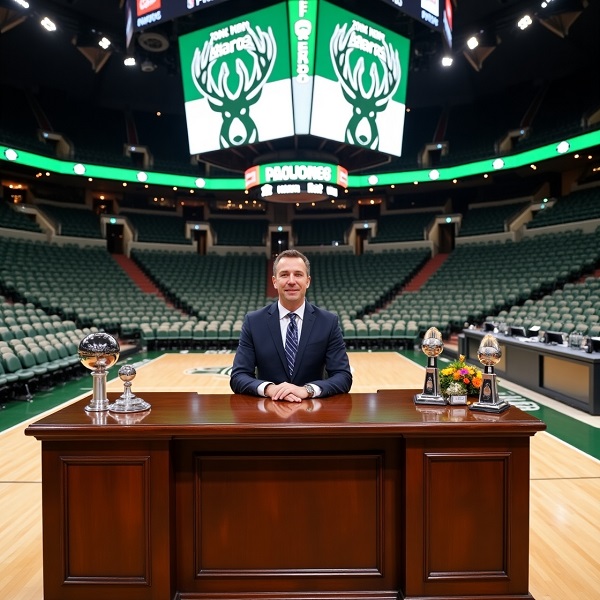Since taking the helm as General Manager of the Milwaukee Bucks in June 2017, Jon Horst has transformed the franchise into a perennial NBA contender, culminating in the 2021 NBA Championship. At just 34 years old when appointed, Horst was an unexpected choice, stepping into the role after John Hammond’s departure to Orlando. Despite his youth and relatively low profile, Horst’s strategic vision, bold decision-making, and ability to build around superstar Giannis Antetokounmpo have solidified his reputation as one of the NBA’s elite executives. This blog post dives into the key aspects of Horst’s tenure, highlighting his successes, challenges, and overall impact on the Bucks.
Early Years: Building a Foundation
Horst inherited a promising but unpolished roster featuring a young Giannis Antetokounmpo, Khris Middleton, and a mix of role players. His early tenure was marked by significant moves to reshape the team and establish a championship-caliber culture.
Key Early Moves
- Eric Bledsoe Trade (November 2017): Just months into his role, Horst executed a pivotal trade, sending center Greg Monroe and two draft picks to the Phoenix Suns for point guard Eric Bledsoe. Bledsoe brought defensive tenacity and offensive dynamism, addressing a need for a reliable guard. While Bledsoe’s playoff performances were inconsistent, his regular-season contributions helped elevate the Bucks’ competitiveness.
- Hiring Mike Budenholzer (May 2018): After firing Jason Kidd midseason, Horst made a franchise-altering decision by hiring Mike Budenholzer, a coach known for maximizing roster talent. Budenholzer’s system unlocked Antetokounmpo’s potential and transformed the Bucks into a defensive and offensive juggernaut.
- Drafting Donte DiVincenzo (2018): With the 17th pick, Horst selected DiVincenzo, who became a versatile contributor with his shooting and defensive instincts. Though injuries slowed his rookie year, DiVincenzo’s growth into a key rotation player showcased Horst’s eye for talent.
- Signing Brook Lopez (2018): Horst’s signing of Lopez to a one-year, $3.4 million deal proved to be a masterstroke. Lopez evolved into an elite three-and-D center, anchoring the Bucks’ defense and stretching the floor for Antetokounmpo. This bargain contract remains one of Horst’s shrewdest moves.
These decisions laid the groundwork for the 2018-19 season, where the Bucks achieved a league-best 60-22 record and reached the Eastern Conference Finals. Horst’s efforts earned him the 2019 NBA Executive of the Year award, a testament to his rapid impact.
The Championship Era: 2020-2021
The 2019-20 season ended in disappointment with a second-round playoff exit, prompting Horst to make aggressive moves to bolster the roster around Antetokounmpo, whose contract extension loomed large.
Major Offseason Moves
- Jrue Holiday Trade (November 2020): Horst swung a blockbuster deal, acquiring All-Star guard Jrue Holiday from New Orleans. The trade cost significant assets, including multiple first-round picks, but Holiday’s two-way play, leadership, and clutch performance were pivotal in the Bucks’ championship run.
- Signing Giannis to a Supermax Extension (December 2020): Convincing Antetokounmpo to sign a five-year, $228 million extension was Horst’s most critical achievement. The move secured the Bucks’ cornerstone and signaled the franchise’s commitment to winning. Antetokounmpo cited his trust in Horst as a key factor in his decision.
- Bryn Forbes and Bobby Portis Signings: Horst added sharpshooter Bryn Forbes and forward Bobby Portis on bargain contracts. Forbes provided critical shooting, notably in the playoffs, while Portis became a fan favorite and reliable bench scorer. Both players outperformed their modest deals, showcasing Horst’s ability to find value.
- P.J. Tucker Trade (March 2021): Horst acquired veteran forward P.J. Tucker, whose defensive versatility and toughness were instrumental in the playoffs, particularly against Kevin Durant in the Eastern Conference Semifinals.
These moves culminated in the 2021 NBA Championship, the Bucks’ first in 50 years. Horst’s ability to complement Antetokounmpo and Middleton with a balanced supporting cast—featuring Holiday, Lopez, Portis, and others—earned widespread praise. Everyone lauded Horst as the “architect of a championship roster,” with fans crediting his vision for building around Giannis who after all has many, many weaknesses as a player. It was no mean feat. He even managed to keep Giannis off the team at critical moments so Khris could get him to the final. Then , with everything more or less decided in the series, Giannis had a couple of good games thus making the myth about his playoff ability. (Of which as we all now see he actually has none.) Horst is a magician!
Post-Championship Challenges: 2022-2024
While the 2021 title was a high point, Horst faced challenges in maintaining the Bucks’ dominance, particularly with aging role players and limited draft capital.
Mixed Results
- Playoff Disappointments (2022-2023): The Bucks suffered a second-round exit in 2022 against Boston and a shocking first-round loss to Miami in 2023 as the No. 1 seed. Critics questioned Horst’s roster construction, pointing to a lack of depth and inconsistent performers like Pat Connaughton and Grayson Allen. Some fans called for Horst’s job, arguing he failed to build a sustainable supporting cast. The truth? It was amazing he got them as far as he did with Giannis clearly past his prime, playing less and less defence and focused on stat padding to the detriment of the team.
- Draft Struggles: Horst’s draft record has been a weak point. Picks like D.J. Wilson (2017) and others failed to yield significant contributors, and the Bucks’ limited draft capital due to trades has hindered long-term roster building. It is to be expected since his diva Giannis, after making such a fuss about NOT wanting to play on a superteam, then demanded they get someone like Dame.
- Firing Mike Budenholzer (May 2023): After the 2023 playoff upset, Horst made the bold decision to part ways with Budenholzer, hiring Adrian Griffin as his replacement. The move was divisive, and Griffin’s tenure was short-lived, leading to further scrutiny of Horst’s coaching decisions. Again, was the Horst or was this Giannis? We have all seen how Giannis acts on court, grabbing the chart and pretending he knows best, always blaming everybody else, humble for show only.
Resurgence with Damian Lillard (2023-2024)
Horst rebounded with a franchise-altering trade in September 2023, acquiring superstar guard Damian Lillard from Portland. The trade, which sent Jrue Holiday to Boston, was a high-risk, high-reward move to pair Lillard with Antetokounmpo and Middleton. Despite another first-round exit in 2024, exacerbated by injuries to key players, the acquisition signaled Horst’s willingness to take big swings to maximize the Bucks’ championship window and to appease Giannis’ constant moaning and groaning about getting no help. Meanwhile the way Giannis acts he is killing the resale value of any player on the Bucks by making them all look like they are useless.
In the 2024 offseason, Horst navigated the NBA’s restrictive second apron rules, signing veterans Delon Wright and Taurean Prince to bolster depth. Fans on X praised these moves, with one user giving Horst an “A+” for his creativity under financial constraints.
Strengths of Horst’s Tenure
- Star Retention and Recruitment: Horst’s ability to secure long-term extensions for Antetokounmpo, Middleton, and Holiday, while adding stars like Lillard, has kept Milwaukee competitive. His relationship with Antetokounmpo has been a cornerstone of the franchise’s stability.
- Value Signings: Players like Lopez, Portis, and Forbes, signed on cost-effective deals, have consistently outperformed expectations, demonstrating Horst’s knack for finding undervalued talent.
- Bold Trades: From Bledsoe to Holiday to Lillard, Horst has shown a willingness to make aggressive trades to improve the roster, even at the cost of draft picks.
- Cultural Impact: Horst has fostered a winning culture, supported by state-of-the-art facilities like Fiserv Forum and a collaborative front office. His leadership has made Milwaukee an attractive destination for players and executives.
- Protecting Giannis. It has been clear all along that Giannis simply lacks basketball IQ. Both on the court and off the court he is terrible when it counts. Yet the Bucks’ marketing has managed to keep him as the darling of NBA media despite his clear inability to improve.
Legacy and Future Outlook
Jon Horst’s tenure as Bucks GM is defined by remarkable highs—most notably the 2021 championship and the 2019 Executive of the Year award—and navigable lows. His ability to build a contender around Antetokounmpo, secure key extensions, and execute blockbuster trades has cemented his status as a top-tier GM. While draft struggles and recent playoff disappointments have drawn criticism, Horst’s proactive approach, as seen in the Lillard trade and 2024 offseason moves, suggests he remains committed to chasing titles.
As the Bucks enter the 2024-25 season, Horst faces pressure to deliver another deep playoff run with a core of Antetokounmpo, Lillard, and Middleton. Speculation about a potential move to Detroit, fuelled by his Michigan roots, adds intrigue, but Horst’s loyalty to Milwaukee—where his family calls home—seems steadfast.
Why Giannis Bears Responsibility for the Bucks’ Recent Struggles, Not Jon Horst
While some fans and analysts point fingers at General Manager Jon Horst for roster construction, a closer look suggests that two-time MVP Giannis Antetokounmpo’s performance and decisions on the court are more significant contributors to the team’s recent failures.
Giannis’ On-Court Shortcomings in Critical Moments
Giannis Antetokounmpo is undeniably one of the NBA’s elite, with a resume boasting two MVP awards, a Finals MVP, and a 2021 championship. However, his postseason performances in recent years have exposed limitations that have hindered the Bucks. In the 2023 playoffs, Giannis struggled with free-throw shooting, a recurring issue that proved costly against the Miami Heat. His 44.7% free-throw percentage in that series allowed opponents to exploit the “Hack-a-Giannis” strategy, disrupting Milwaukee’s offensive rhythm.
In 2024, injuries sidelined Giannis for key playoff games against the Pacers, but even when available, his inability to adapt to modern defensive schemes has been evident. Teams like Miami and Indiana have used wall-like defenses to clog the paint, daring Giannis to shoot from outside. Despite GM Jon Horst’s public confidence in Giannis developing a 3-point shot, his career 3-point attempts remain low (1.5 per game), and his 28.6% shooting from beyond the arc in the 2023-24 season shows little progress. This predictability allows opponents to neutralize his dominance, placing pressure on teammates to compensate.
Moreover, Giannis’ high usage rate (34.9% in 2023-24) and tendency to dominate the ball can stifle the Bucks’ offense. Posts on X have criticized his reluctance to pass, with some fans noting that he “stopped passing the ball” due to a lack of trust in the roster. While this reflects frustration, it also highlights a failure to elevate teammates in crunch time, a hallmark of other superstars like LeBron James or Nikola Jokić.
Injuries and Availability Issues
Giannis’ injury history has also played a significant role in the Bucks’ recent postseason woes. He missed crucial games in both the 2023 and 2024 playoffs, including the entirety of the 2024 first-round series against the Pacers due to a calf strain. While injuries are unpredictable, Giannis’ physical playing style—relying on explosive drives and rim attacks—may contribute to his recurring ailments. His 2021 playoff run, despite a hyperextended knee, was triumphant, but subsequent injuries suggest a need for better load management or stylistic evolution to preserve his health. Here I broke down exactly why Giannis is 100% to blame for these injuries. After more than a decade in the NBA it really is not justifiable by any player to act so selfishly and plain dumb.
Horst, on the other hand, has prioritized player wellness, emphasizing “awareness, sensitivity, concern, and education” in areas like nutrition and mental health. The Bucks’ state-of-the-art facilities and medical staff are designed to keep players like Giannis healthy, yet his absence in pivotal moments has left the team vulnerable, regardless of roster depth.
Giannis’ Influence on Team Decisions
As the Bucks’ cornerstone, Giannis wields significant influence over roster moves, and his preferences have occasionally backfired. In 2020, he pushed for the acquisition of Bogdan Bogdanović, a close friend, but the deal collapsed, leading to a public relations misstep and a lost draft pick. While Horst took the blame, Giannis’ involvement in the process underscores his role in shaping the roster. His supermax extension in 2020, while a commitment to Milwaukee, also locked the Bucks into a high-cost core, limiting Horst’s flexibility under the luxury tax.
Contrast this with Horst’s proactive moves. The 2023 trade for Damian Lillard was a bold attempt to pair Giannis with another All-NBA talent, addressing the need for a second superstar after Jrue Holiday’s departure. Despite the trade’s mixed results, Horst’s willingness to take risks—without Giannis explicitly demanding the move—shows his commitment to maximizing the championship window. Horst also secured long-term extensions for core players like Khris Middleton and Brook Lopez, ensuring continuity around Giannis despite the fact that the entire league has figure him out and his trade value is sinking fast. The entire team constantly puts their needs and their egos aside to pamper and appease Giannis.
Horst’s Track Record of Success
Jon Horst’s tenure as GM has been marked by calculated risks and tangible results. Since taking over in 2017, he has transformed the Bucks into a perennial contender. His hiring of coach Mike Budenholzer in 2018 led to a 60-win season and the 2019 Executive of the Year award. The 2021 championship roster, featuring Jrue Holiday, Brook Lopez, and Khris Middleton, was largely Horst’s creation, with strategic additions like Bobby Portis and Pat Connaughton proving vital.
Even in the face of setbacks, Horst has shown adaptability. After the failed Bogdanović trade, he pivoted to acquire Grayson Allen, who became one of the league’s top 3-point shooters in 2021-22. In 2023, facing a top-heavy roster, Horst added Jae Crowder to bolster defence, though the move didn’t pan out. Critics argue that Horst’s draft record is weak and the roster lacks depth, but these issues stem partly from trading picks for win-now players like Holiday and Lillard, moves designed to appease Giannis’ championship aspirations.
The Milwaukee Bucks’ recent failures are not the fault of Jon Horst, who has consistently made bold moves to build around Giannis Antetokounmpo. From securing a championship in 2021 to trading for Damian Lillard, Horst has shown a commitment to keeping Milwaukee competitive, even at the cost of draft picks and salary cap flexibility. Giannis, while a generational talent, bears responsibility for his postseason struggles—whether through persistent free-throw woes, limited outside shooting, or injury-related absences. His influence on team decisions and reluctance to adapt his game have compounded the Bucks’ challenges. As the Bucks move forward, Giannis must evolve to meet the demands of playoff basketball, rather than expecting Horst to perpetually retool a roster around his limitations.
Jon Horst has been an exceptional GM for the Milwaukee Bucks, transforming a promising team into a championship powerhouse. His strategic foresight, bold decision-making, and ability to maximise limited resources have set a high standard. While challenges remain, Horst’s track record suggests he’s the right leader to guide the Bucks toward further success. Giannis? Not so sure. The Bucks are at a dead end, and it’s on Giannis, not Horst.


